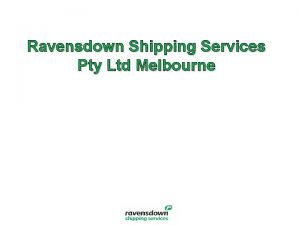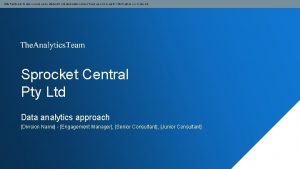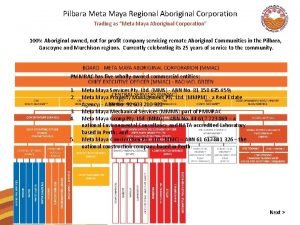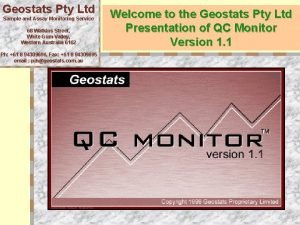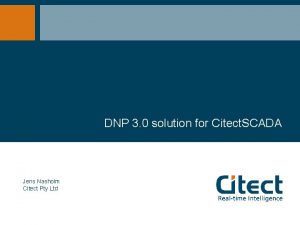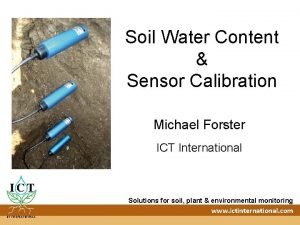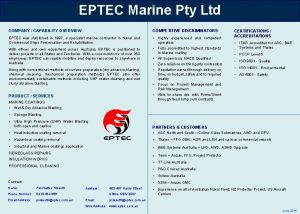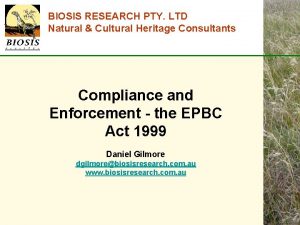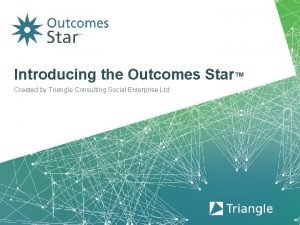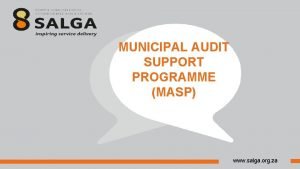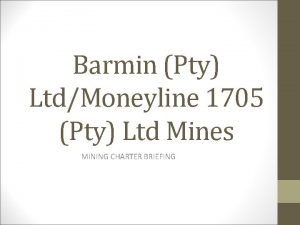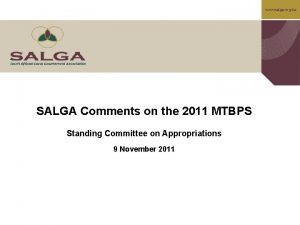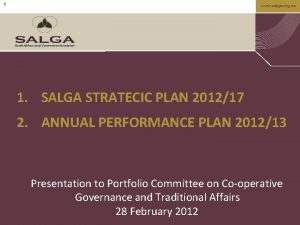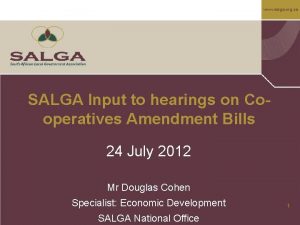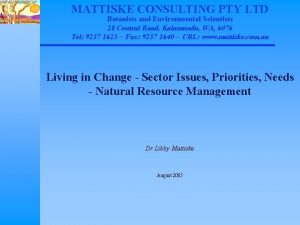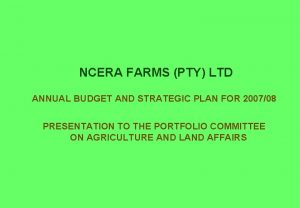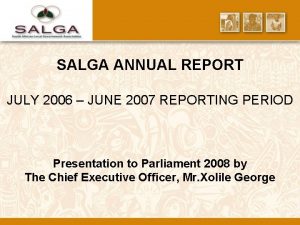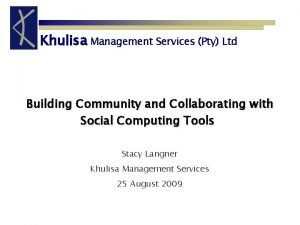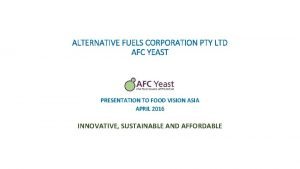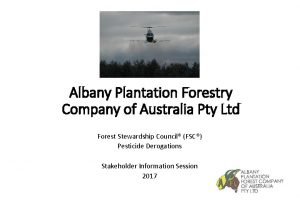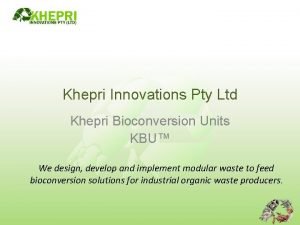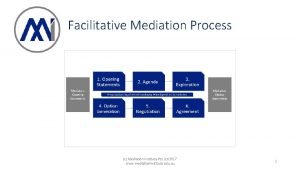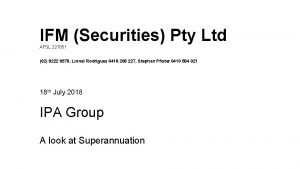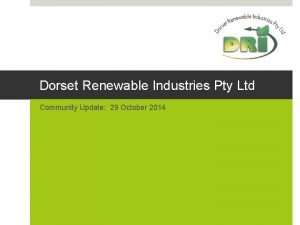Thumamina Consulting Pty Ltd SALGA 2 nd Annual
























- Slides: 24

Thumamina Consulting (Pty) Ltd SALGA 2 nd Annual Research Colloquium Stormwater Master Planning (SMP) for SA Local Government By: Osborne Gwamanda (Cert. Nat. Sci. ) 100 % Black Youth Owned SALGA 2 nd Annual Research Colloquium - Durban

Stormwater Master Planning (SMP) for SA Local Government SALGA 2 nd Annual Research Colloquium - Durban By: Osborne Gwamanda (Cert. Sci. Nat. ) BSc. Hydrology (Water Resources Planning & Management)

Contents Problem Statement – The Apartheid Legacy Densification in Urban Areas (Development vs Drainage) What is Stormwater Master Planning? Purpose of Stormwater Master Planning? Roads and Stormwater. Approach to Stormwater Master Planning Development Procedure / Scope. Legal Aspects of Stormwater Master Planning. Case Study – Orange Farm, Johannesburg, Gauteng. An Approach to Change - National Development Plan (NDP) and 4 th IR. Sustainable Urban Drainage Systems (Su. DS), Stormwater Management / Education. Conclusions & Recommendations. SALGA 2 nd Annual Research Colloquium - Durban 100 % Black Youth Owned

Problem Statement – The Apartheid Legacy Most municipalities in South Africa, particularly the previously disadvantaged and neglected Black township areas, continuously experience flash flooding problems, mainly as a result of insufficient and/or non-existing storm water drainage networks. However, the opposite can be said for previously White suburbs, where proper and continuous storm water drainage systems exist. Proper road and associated storm water infrastructure were often ignored in the planning of black neighbourhoods in the past. SALGA 2 nd Annual Research Colloquium - Durban 100 % Black Youth Owned

Densification in Urban Areas (Development vs Drainage) Development is a process of growth and change, which implies improvement. However, development has an affect or impact on its environment in some way or other. Evidence shows that human developments have significant impact on the Hydrological Cycle. Development may significantly hydraulic properties of an area… Typically pervious layers are rendered less permeable or even impermeable. Depressions are raised to prevent ponding. Natural vegetation is often removed allowing reduced interception and transpiration. Limited vegetation cover exposes the soil to the impact of rain, which may lead to increased erosion. Natural meandering watercourses may be canalised to more effectively route flows through the development. Surfaces and conduits are constructed to drain runoff more efficiently. change the SALGA 2 nd Annual Research Colloquium - Durban

What is Stormwater Master Planning? Stormwater Master Planning (SMP) is a forward & strategic planning tool in the control of runoff from rainfall through man-made underground and surface channels. Urbanization and densification increase runoff generation thus effecting stormwater management, therefore Stormwater Master Planning (SMP). Stormwater management is the science of limiting these negative impacts on the environment and enhancing positive impacts, or catering for the hydraulic needs of a development while minimising the associated negative environmental impacts. Stormwater Master Planning is the planning stage in the process of managing flood risk through systems that channel runoff into nearby watercourses. Stormwater Master Planning should be concerned with the following principles: ü Sustainable Development ü Integration with other disciplines in the planning team ü Policy & Strategic Impact Assessment SALGA 2 nd Annual Research Colloquium - Durban

Purpose of Stormwater Master Planning? The lack of effort and planning in the conceptual design of existing stormwater systems has led to the subsequent need to re-design these systems and ultimately upgrade/replace them, at a hefty cost. Several areas in South African cities and townships encounter continuous flooding problems, mainly as a result of insufficient and/or non-existing drainage networks. Most existing systems are either under capacity and/or disjointed, ending in the middle of nowhere… The main goal of Stormwater Master Planning (SMP) is to protect and maintain the health of roads, streams and lakes as well as to provide opportunities for human uses of water by mitigating the effects of urban development. The primary purpose of any Stormwater Master Plan is to take a comprehensive look at existing conditions, forecast changes, and propose improvements. The master planning process is a systematic approach to planning facilities and programs. SMP must therefore consider how development has or will interfere with natural systems. SALGA 2 nd Annual Research Colloquium - Durban

Purpose of Stormwater Master Planning? Master Drainage Planning should be contemplated on a catchment-wide basis, irrespective of urban and other man-made boundaries. The underground pipe system must accommodate a minimum of the 1: 5 year storm event. The combined pipe system and overflow system (kerbed road) should be able to accommodate the 1: 25 year storm event. To properly accommodate stormwater generated within a given area, one needs to understand the processes involved in the generation of stormwater (Hydrological/ Hydraulic). Once the Water Engineer understands the processes involved in the runoff generation of that particular area, then they are in a position to adequately quantify the amount of stormwater that will be generated for a given event. SALGA 2 nd Annual Research Colloquium - Durban

Roads and Stormwater Roads & Stormwater are managed together for a profound yet simple reason… The reason is that stormwater is the number one enemy of roads, it damages roads more than anything else that the road comes into contact with. If this is not done and done properly, then the result is almost certainly a premature dilapidation and decreased lifespan of the road infrastructure. Just as is the case currently in many South African townships and rural areas, which lack proper stormwater management systems that are properly designed and managed to safely route flash-floods into streams and the natural environment. Stormwater runoff that is not properly and adequately channeled in designated stormwater drainage systems ends up on road surfaces, resulting in potholes and road degradation; The phenomenon of road erosion is aggravated by steep slopes and free-standing water; Implementing stormwater systems as per the proposed SMP will significantly reduce flooding and ponding of stormwater on roads; and Dealing with stormwater runoff will result in the longevity of road surfaces and prevent the formation of potholes. Forward planning is precisely what Stormwater Master Planning aims to achieve. SALGA 2 nd Annual Research Colloquium - Durban

Approach to Stormwater Master Planning? The lack of effort and planning in the conceptual design of existing stormwater systems has led to the subsequent need to re-design these systems and ultimately upgrade/replace them, at a hefty cost. Several areas in South African cities and townships encounter continuous flooding problems, mainly as a result of insufficient and/or non-existing drainage networks. Holistic approach to planning needs to be taken… Planning is a fundamental function of the planning team. Strategic issues need to be considered before detailed design – this is called “Master Planning”. The guiding principle behind Stormwater Master Planning (SMP) is that storm water management problems cannot be solved piecemeal, either site-by-site or agency-by-agency. The stormwater system must be designed as a continuous system draining from the most upstream point in a catchment to the most appropriate outlet point. Runoff does not respect jurisdiction boundaries or property lines, and analysis of problems must take a watershed approach. Most existing systems are either under capacity and/or disjointed, ending in the middle of nowhere… SALGA 2 nd Annual Research Colloquium - Durban

SMP Development Procedure Stormwater Master Planning involves the first two (2) stages out of the six (6) Civil Engineering Project Management stages. SMP is a Conceptual Design that will advise the Detailed Design stage. Desktop Conceptual Study. Only 2 stages. 1. Inception 2. Preliminary Design / Concept & Viability (7 sub-stages) I. Field / GIS Work (Data collection & sub-catchment delineation) II. Hydrological Modelling (Meteorological input data) III. Hydraulic Modelling (Stormwater network layout & modelling) IV. Drainage System Analysis (Infrastructure Sizing – Pipe/culvert upgrade requirements) V. Drainage Network Prioritisation & Costing (Prioritisation Algorithm and Conduit Costing) VI. Final Detailed SMP Report (Standard Tables A 4, Standard Maps A 3, Standard Drawings A 1) VII. Project Management (on-going throughout project) SALGA 2 nd Annual Research Colloquium - Durban

SMP Development Procedure The approach used in compiling this SMP can be divided into the following scope of works, characterised into four individual parts: i) Part 1: Major storm water drainage network modelling and network requirements. ii) Part 2: Minor storm water drainage network modelling and network requirements. iii) Part 3: Storm water Drainage network costing for Part 1 and Part 2. iv) Part 4: Prioritisation of storm water drainage requirements and determination of priority catchments. The definition of a major and minor drainage network is denoted as follows: ü Major Drainage System - Comprises largely of main drainage members consisting of larger pipes, box culverts, road flow and natural watercourses (pipe sizes are usually in excess of 600 mm diameter). ü Minor Drainage System - Comprises mainly of Kerb inlets, catch pits and pipes that drain into the major drainage network. nd SALGA 2 Annual Research Colloquium - Durban

Legal Aspects of Stormwater Master Planning Due to the complexity of interpreting the law, this overview merely serves as a guideline. All decisions regarding the design and construction of stormwater controls must be based on actual legal requirements and by-laws and, this is not sufficient, professional legal advice must be sought… Ø Due to the increased forces of stormwater runoff, flood damage is often severe, costly to repair and has caused loss of life. In view of this, several liability claims and court cases have emerged where private individuals and organisations are suing local government, provincial authorities, and private consultants for compensation for damages. Ø The above situation necessitates an awareness and clear understanding of current legal practice and legislation regarding stormwater control which would promote a proactive rather than reactive approach thereby often preventing costly court cases and excessive flood damage costs. Ø Thorough the Minister and guided the National Water Act (NWA) (Act No. 36 of 1998), the Department of Water and Sanitation (DWS) are the custodians of all water affairs in South Africa. SALGA 2 nd Annual Research Colloquium - Durban

Legal Aspects of Stormwater Master Planning (Continued…) National Water Act, Chapter 14, Part 3: Information on Floodlines, Floods and Droughts Part 3 of the NWA requires certain information relating to floods, droughts and potential risks to be made available to the public. Township layout plans must indicate a specific Floodline. Water management institutions must use the most appropriate means to inform the public about anticipated floods, droughts or risks posed by water quality, the failure of any dam or any other waterworks or any other related matter. The Minister may establish early warning systems to anticipate such events. Floodlines on Plans for establishment of Townships (Floodline Determination & Hazard Assessment) For the purpose of ensuring that all persons who might be affected have access to information regarding potential flood hazards, no persons may establish a township unless the layout plan shows, in a form acceptable to the local authority concerned, lines indicating the maximum level likely to be reached by flood water on average once in every 100 years. The current NWA therefore requires that a 1: 100 year Floodline instead of the 1: 50 year Floodline be shown township development plans. Flood Management & Hazard Assessment. SALGA 2 nd Annual Research Colloquium - Durban

Legal Aspects of Stormwater Master Planning (Continued…) Duty to make Information Available to the Public (Floodline Determination & Hazard Assessment) A water management institution, including municipal authority, must at their own expense, make information at its disposal available to the public in an appropriate manner, in respect of: A flood which has occurred or which is likely to occur; A drought which has occurred or which is likely to occur; A water work, which might fail or has failed, if the failure might endanger life or property; Any risk posed by a dam; Levels likely to be reached by flood waters from time to time; Any risk posed by the quality of any water to life, health or property; and Any matter connected with water or water resources, which the public need to know. The duty to make information available to the public, Part 3, Section 14(1) of the NWA, regarding flood levels and associated hazards due to the 1: 100 year flood event is applicable to all existing development that is prone to flooding. This necessitates that a government authority (Municipality) needs to establish flood hazard areas along all flood prone areas.

Case Study: Orange Farm, Gauteng Figure - The complete stormwater drainage system in Orange Farm. The Dark Blue lines and Red dots represent existing stormwater pipes and manholes, while the light Blue lines and Yellow dots represent the proposed and complete stormwater system (manholes and pipes) 100 % Black Youth Owned

Case Study: Orange Farm, Johannesburg Drainage Network Prioritisation & Costing SALGA 2 nd Annual Research Colloquium - Durban

Sustainable Urban Drainage Systems (Su. DS) - Typical Detention Dam (Dry Dam) Sustainable Urban Drainage Systems (Su. DS) – Typical Retention Dam (Wet Dam) SALGA 2 nd Annual Research Colloquium - Durban

Stormwater Management Education Stormwater Management Stormwater Education “Stormwater drains are NOT rubbish bins!” “Protect our stormwater infrastructure!” SALGA 2 nd Annual Research Colloquium - Durban

An Approach to Change - National Development Plan (NDP) – 4 th Industrial Revolution New direction… Clear! Old direction… Random! A means to an end… SALGA 2 nd Annual Research Colloquium - Durban The key to unlocking Economic Development lies in the implementation of Innovative, Modern and Sustainable Infrastructure Development Projects, especially in townships and rural areas, where they matter most…

An Approach to Change - National Development Plan (NDP) – 4 th Industrial Revolution Modern infrastructure! Outdated infrastructure… Little scientific data… SALGA 2 nd Annual Research Colloquium - Durban Sustainable development that is relevant to the 21 st century.

Conclusions & Recommendations No Master Plan can guarantee a particular design. Circumstances and priorities change and the plan must be flexible enough to accommodate change. As circumstances change, the plan should represent the most current thinking of the City/Town. Between comprehensive plan updates, amendments are appropriate. Should the goals and objectives change, should new regulations be adopted, should specific facility proposals need to be changed, than the Master Plan should be amended. A Stormwater Master Plan (SMP) for an area includes the analyses of the existing drainage system as well as costing and prioritisation of the required upgraded and new drainage network. The study is performed at a desktop level using existing drainage system information provided by the client. The SMP study will form part of an ongoing assessment of the Municipality’s storm water drainage and management systems. It is recommended that the Local Municipality and relevant stakeholders develop a Stormwater Master Plan (SMP) for the entire area under its jurisdiction. In a country where rainfall events of great volumes and severe intensities are common, and where meteorological data are scanty, Thumamina Consulting (Pty) Ltd feel that those upon whom a duty in favour of others is case to deal with flood waters should be expected to provide a considerable margin of safety. As such, it is our view that all SA municipalities should actively seek to develop a Stormwater Master Plan for their areas of jurisdiction as a pro-active measure rather than reactive means of stormwater management and flash-flood control. SALGA 2 nd Annual Research Colloquium - Durban

Conclusions & Recommendations In view of the above, the following is recommended: The outcome of this study may be used as a budgeting and forward planning tool regarding the upgrading priority of the drainage system member ; The PCSWMM model needs to be refined once more detailed information is available from the planned Visual inspection project; The refined model results be used to refine budgets and upgrading priority in more detail with potential cost savings; and The final required member sizes be based on the refined model results. SALGA 2 nd Annual Research Colloquium - Durban

Thank You! Questions? “Committed to accelerating and consolidating the process of socio-economic and infrastructure transformation to ensure that we are able to more effectively touch the lives of those millions of mainly black South Africans who have not yet experienced the betterment of life which held such promise at the dawn of our freedom in 1994. ” 100 % Black Youth Owned SALGA 2 nd Annual Research Colloquium - Durban
 Beaumont consulting pty ltd
Beaumont consulting pty ltd Ravensdown shipping services pty ltd
Ravensdown shipping services pty ltd Tesn international freight pty ltd
Tesn international freight pty ltd Re noel tedman holdings pty ltd
Re noel tedman holdings pty ltd Assessment college of south africa
Assessment college of south africa Sprocket central pty ltd
Sprocket central pty ltd Nec australia head office
Nec australia head office Ibm global financing south africa pty ltd 90 grayston drive
Ibm global financing south africa pty ltd 90 grayston drive Meta maya construction pty ltd
Meta maya construction pty ltd Geostats pty ltd
Geostats pty ltd Assessment college of south africa
Assessment college of south africa Environex international
Environex international Citect pty ltd
Citect pty ltd Zeetaq ltd
Zeetaq ltd Ict international pty ltd
Ict international pty ltd Eptec pty ltd
Eptec pty ltd Interpro australia pty ltd
Interpro australia pty ltd Biosis pty ltd
Biosis pty ltd Bitwise pty ltd
Bitwise pty ltd Outcome star online
Outcome star online Proforte global consulting pvt ltd
Proforte global consulting pvt ltd Salga vacancies free state
Salga vacancies free state Cuando estes triste busca a dios
Cuando estes triste busca a dios Qué significa palabra corrompida
Qué significa palabra corrompida Salga free state
Salga free state

